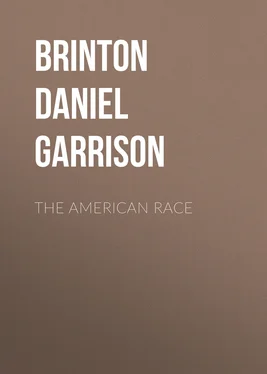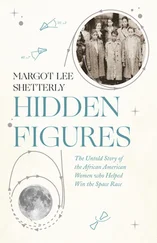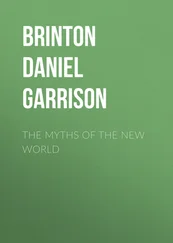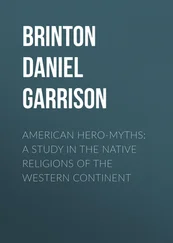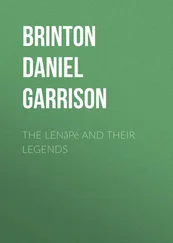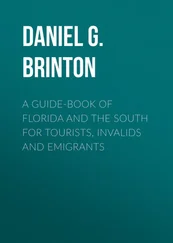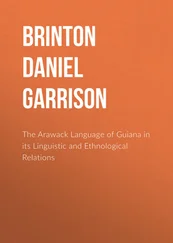Daniel Brinton - The American Race
Здесь есть возможность читать онлайн «Daniel Brinton - The American Race» — ознакомительный отрывок электронной книги совершенно бесплатно, а после прочтения отрывка купить полную версию. В некоторых случаях можно слушать аудио, скачать через торрент в формате fb2 и присутствует краткое содержание. Жанр: foreign_antique, История, История, foreign_edu, на английском языке. Описание произведения, (предисловие) а так же отзывы посетителей доступны на портале библиотеки ЛибКат.
- Название:The American Race
- Автор:
- Жанр:
- Год:неизвестен
- ISBN:нет данных
- Рейтинг книги:4 / 5. Голосов: 1
-
Избранное:Добавить в избранное
- Отзывы:
-
Ваша оценка:
- 80
- 1
- 2
- 3
- 4
- 5
The American Race: краткое содержание, описание и аннотация
Предлагаем к чтению аннотацию, описание, краткое содержание или предисловие (зависит от того, что написал сам автор книги «The American Race»). Если вы не нашли необходимую информацию о книге — напишите в комментариях, мы постараемся отыскать её.
The American Race — читать онлайн ознакомительный отрывок
Ниже представлен текст книги, разбитый по страницам. Система сохранения места последней прочитанной страницы, позволяет с удобством читать онлайн бесплатно книгу «The American Race», без необходимости каждый раз заново искать на чём Вы остановились. Поставьте закладку, и сможете в любой момент перейти на страницу, на которой закончили чтение.
Интервал:
Закладка:
In certain directions doubtless the tendency has been to push this uniformity too far, especially with reference to governmental institutions. Mr. Morgan’s assertions upon this subject were too sweeping. Nevertheless he was the first to point out clearly that ancient American society was founded, not upon the family, but upon the gens, totem or clan, as the social unit. 48 48 The word totem is derived from the Algonkin root od or ot and means that which belongs to a person or “his belongings,” in the widest sense, his village, his people, etc.
The gens is “an organized body of consanguineal kindred” (Powell), either such in reality, or, when strangers have been adopted, so considered by the tribal conscience. Its members dwell together in one house or quarter, and are obliged to assist each other. An indeterminate number of these gentes, make up the tribe, and smaller groups of several of them may form “phratries,” or brotherhoods, usually for some religious purpose. Each gens is to a large extent autonomic, electing its own chieftain, and deciding on all questions of property and especially of blood-revenge, within its own limits. The tribe is governed by a council, the members of which belong to and represent the various gentes. The tribal chief is elected by this council, and can be deposed at its will. His power is strictly limited by the vote of the council, and is confined to affairs of peace. For war, a “war chief” is elected also by the council, who takes sole command. Marriage within the gens is strictly prohibited, and descent is traced and property descends in the female line only.
This is the ideal theory of the American tribal organization, and we may recognize its outlines almost anywhere on the continent; but scarcely anywhere shall we find it perfectly carried out. The gentile system is by no means universal, as I shall have occasion to point out; where it exists, it is often traced in the male line; both property and dignities may be inherited directly from the father; consanguine marriage, even that of brother and sister or father and daughter, though rare, is far from unexampled. 49 49 Among the Brazilian hordes, for instance, Martius, Beiträge zur Ethnographie und Sprachenkunde Amerikas , Bd. I. s. 116 (Leipzig, 1867).
In fact, no one element of the system was uniformly respected, and it is an error of theorists to try to make it appear so. It varied widely in the same stock and in all its expressions. 50 50 Thus the Heiltsuk and Kwakiutl of the northwest coast, though speaking close dialects of the same stock, differ fundamentally in their social organization. That of the former is matriarchal, of the latter patriarchal. Boas, Fifth Report to the Brit. Assoc. Adv. Science , p. 38.
This is markedly true, for instance, in domestic architecture. The Lenâpé, who were next neighbors to the Five Nations, had nothing resembling their “long house,” on which Morgan founded his scheme of communal tenements; and the efforts which some later writers have made to identify the large architectural works of Mexico and Yucatan with the communal pueblos of the Gila valley will not bear the test of criticism.
The foundation of the gentile, as of any other family life, is, as I have shown elsewhere, 51 51 Races and Peoples; Lectures on the Science of Ethnography , p. 55 (David McKay, Philadelphia.)
the mutual affection between kindred. In the primitive period this is especially between the children of the same mother, not so much because of the doubt of paternity as because physiologically and obviously it is the mother in whom is formed and from whom alone proceeds the living being. Why this affection does not lead to the marriage of uterine brothers and sisters—why, on the contrary, there is almost everywhere a horror of such unions—it is not easy to explain. Darwin suggests that the chief stimulus to the sexual feelings is novelty, and that the familiarity of the same household breeds indifference; and we may accept this in default of a completer explanation. Certainly, as Moritz Wagner has forcibly shown, 52 52 Die Entstehung der Arten durch Räumliche Sonderung (Basel, 1889).
this repugnance to incest is widespread in the species, and has exerted a powerful influence on its physical history.
In America marriage was usually by purchase, and was polygamous. In a number of tribes the purchase of the eldest daughter gave the man a right to buy all the younger daughters, as they reached nubile age. The selection of a wife was often regarded as the concern of the gens rather than of the individual. Among the Hurons, for instance, the old women of the gens selected the wives for the young men, “and united them with painful uniformity to women several years their senior.” 53 53 J. W. Sanborn, Legends, Customs and Social Life of the Seneca Indians , p. 36 (Gowanda, N. Y., 1878).
Some control in this direction was very usual, and was necessary to prevent consanguine unions.
The position of women in the social scheme of the American tribes has often been portrayed in darker colors than the truth admits. As in one sense a chattel, she had few rights against her husband; but some she had, and as they were those of her gens, these he was forced to respect. Where maternal descent prevailed, it was she who owned the property of the pair, and could control it as she listed. It passed at her death to her blood relatives and not to his. Her children looked upon her as their parent, but esteemed their father as no relation whatever. An unusually kind and intelligent Kolosch Indian was chided by a missionary for allowing his father to suffer for food. “Let him go to his own people,” replied the Kolosch, “they should look after him.” He did not regard a man as in any way related or bound to his paternal parent.
The women thus made good for themselves the power of property, and this could not but compel respect. Their lives were rated at equal or greater value than a man’s; 54 54 Father Ragueneau tells us that among the Hurons, when a man was killed, thirty gifts were required to condone the offence, but when a woman was the victim, forty were demanded. Relation des Jesuits , 1635.
instances are frequent where their voice was important in the council of the tribe; nor was it very rare to see them attaining the dignity of head chief. That their life was toilsome is true; but its dangers were less, and its fatigues scarce greater, than that of their husbands. Nor was it more onerous than that of the peasant women of Europe to-day.
Such domestic arrangements seem strange to us, but they did not exclude either conjugal or parental affection. On the contrary, the presence of such sentiments has impressed travelers among even the rudest tribes, as the Eskimos, the Yumas and the hordes of the Chaco; 55 55 Dr. W. H. Corbusier, in American Antiquarian , Sept., 1886; Dr. Amedée Moure, Les Indiens de Mato Grosso , p. 9 (Paris, 1862).
and Miss Alice Fletcher tells me she has constantly noted such traits in her studies of life in the wigwam. The husband and father will often undergo severe privations for his wife and children.
The error to which I have referred of classifying the natives into wild and civilized tribes has led to regarding the one as agricultural, and the other as depending exclusively on hunting and fishing. Such was not the case. The Americans were inclined to agriculture in nearly all regions where it was profitable. Maize was cultivated both north and south to the geographical extent of its productive culture; beans, squashes, pumpkins, and potatoes were assiduously planted in suitable latitudes; the banana was rapidly accepted after its introduction, even by tribes who had never seen a white man; cotton for clothing and tobacco as a luxury were staple crops among very diverse stocks. The Iroquois, Algonkins and Muskokis of the Atlantic coast tilled large fields, and depended upon their harvests for the winter supplies. The difference between them and the sedentary Mexicans or Mayas in this respect was not so wide as has been represented.
Читать дальшеИнтервал:
Закладка:
Похожие книги на «The American Race»
Представляем Вашему вниманию похожие книги на «The American Race» списком для выбора. Мы отобрали схожую по названию и смыслу литературу в надежде предоставить читателям больше вариантов отыскать новые, интересные, ещё непрочитанные произведения.
Обсуждение, отзывы о книге «The American Race» и просто собственные мнения читателей. Оставьте ваши комментарии, напишите, что Вы думаете о произведении, его смысле или главных героях. Укажите что конкретно понравилось, а что нет, и почему Вы так считаете.
